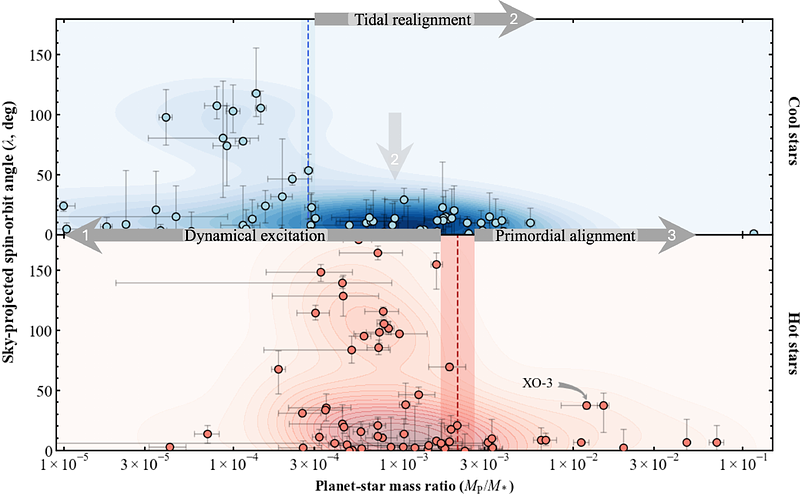From Misaligned Sub-Saturns to Aligned Brown Dwarfs: The Highest $M_{\rm p}/M{_*}$ Systems Exhibit Low Obliquities, Even around Hot Stars

From Misaligned Sub-Saturns to Aligned Brown Dwarfs: The Highest $M_{\rm p}/M{_*}$ Systems Exhibit Low Obliquities, Even around Hot Stars
Jace Rusznak, Xian-Yu Wang, Malena Rice, Songhu Wang
AbstractWe present a pattern emerging from stellar obliquity measurements in single-star systems: planets with high planet-to-star mass ratios ($M_{\rm p}/M{_*}$$>$ $2\times10^{-3}$) -- such as super-Jupiters, brown dwarf companions, and M-dwarfs hosting Jupiter-like planets -- tend to be aligned, even around hot stars. This alignment represents a 3.7$\sigma$ deviation from the obliquity distribution observed in systems with lower mass ratios ($M_{\rm p}/M{_*}$$<$ $2\times10^{-3}$), which predominantly include Jupiters and sub-Saturns. The only known outlier system, XO-3, exhibits misalignment confirmed via our newly collected Rossiter-McLaughlin effect measurement ($\lambda=41.8^{+2.1}_{-2.0}$ degrees). However, the relatively large $\textit{Gaia}$ Renormalized Unit Weight Error (RUWE) of XO-3 suggests that it may harbor an undetected binary companion, potentially contributing to its misalignment. Given that tidal realignment mechanisms are weak for hot stars, the observed alignment in high $M_{\rm p}/M{_*}$ systems is likely $\textit{primordial}$ rather than resulting from tidal interactions. One possible explanation is that only dynamically isolated planets can continue accreting gas and evolve into super-Jupiters while maintaining their primordial alignment. Conversely, planets formed in compact configurations may be unable to grow beyond the gap-opening mass, for which our work suggests an empirical boundary $M_{\rm p}/M{_*}$$=$ $2\times10^{-3}$, identified between aligned high $M_{\rm p}/M{_*}$ systems and misaligned low $M_{\rm p}/M{_*}$ systems, with dynamical instabilities contributing to the diverse spin-orbit misalignments observed in the latter.